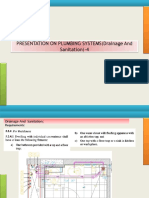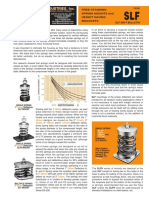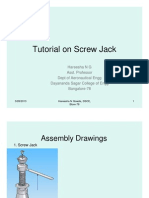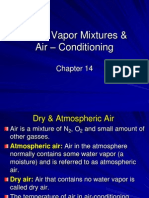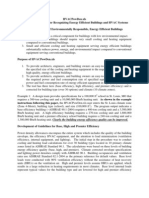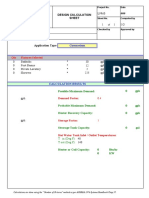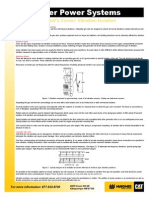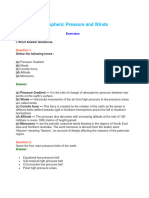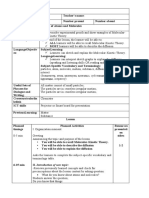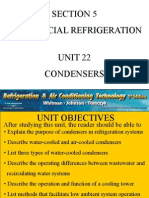Por Example 11
Por Example 11
Uploaded by
rui annCopyright:
Available Formats
Por Example 11
Por Example 11
Uploaded by
rui annOriginal Description:
Copyright
Available Formats
Share this document
Did you find this document useful?
Is this content inappropriate?
Copyright:
Available Formats
Por Example 11
Por Example 11
Uploaded by
rui annCopyright:
Available Formats
Chapter03.
qxd 6/15/04 2:31 PM Page 62
62 Chapter 3 Moist Air Properties and Conditioning Processes
from state 1 to state 2, it is not practical to perform it in that way. The heating and
humidification processes are usually carried out separately, shown in Figs. 3-6 and 3-7
as processes 1 − χ and χ − 2.
Adiabatic Humidification of Moist Air
When moisture is added to moist air without the addition of heat, Eq. 3-38b becomes
i2 − i1 ∆i
= iw = (3-40)
W2 − W1 ∆W
Close examination of the protractor on Chart 1a reveals that ∆i/∆W can vary from pos-
itive infinity on the left to negative infinity on the right. Therefore, in theory, the adi-
abatic humidification process can take many different paths depending on the
condition of the water used. In practice the water will vary from a liquid at about 50 F
(10 C) to a saturated vapor at about 250 F (120 C). The practical range of ∆i/∆W is
shown on the chart and protractor of Fig. 3-8.
EXAMPLE 3-6
Moist air at 60 F db and 20 percent relative humidity enters a heater and humidifier
at the rate of 1600 cfm. Heating of the air is followed by adiabatic humidification so
that it leaves at 115 F db and a relative humidity of 30 percent. Saturated water vapor
at 212 F is injected. Determine the required heat transfer rate and mass flow rate of
water vapor.
SOLUTION
Figure 3-6 is a schematic of the apparatus. Locate the states as shown in Fig. 3-7 from
the given information and Eq. 3-40 using the protractor feature of the psychrometric
chart. Process 1 − χ is sensible heating; therefore, a horizontal line to the right of
state 1 is constructed. Process χ − 2 is determined from Eq. 3-40 and the protractor:
1.0 1.0
SHF
0.030
S ens
5000
0.8 2 .0
0.6 – 8 .0
ib
le heat = – 2 4 .0 50 0.028
0.5
300
4 t .0
0. T otal hea
– 1 0 .5
15
60
– .3
.0
0 2
Humidity ratio (W),pounds of moisture per pound of dry air
3
–0
85
0.026
0.
.0
00
– 0.
0.2
0.1
00
10
45
1
0
15
00 0.024
cal
cti
80
Pra ge
40
55
0.022
ity
ran
id
14
m
85
.5
hu
ir 0.020
%
vol
ya
e
80
35 2a
tiv
dr
75
um
la
of F 0.018
Re
50
e,
e, f
nd r 80
%
ou tu
60
ra
t
rp
3
30 pe
0.016
70
pe
per
m
Bt
u te
pou
, n 0.014
14.
py tio 75
al ra 65
45
nd
25 %
2b
0
th tu 40
En Sa 0.012
of d
60
ry
70
FW 0.010
air
20
et b
55 ulb
40
0.008
50 20%
13.
60
15
45
5
Dry bulb,F
0.006
35
40
50
55 1
13.0
0.004
35
45
40
35 0.002
25 30 Dry bulb temperature, F
x
100
105
110
115
120
12.
35
40
45
50
55
65
75
80
85
90
95
70
60
30
5
10 15 20 25
Figure 3-8 Practical range of adiabatic humidifying processes.
Chapter03.qxd 6/15/04 2:31 PM Page 63
3-5 Classic Moist Air Processes 63
∆i = iw = 1150.4 Btu/ lbm
∆W
where iw is read from Table A-1a. A parallel line is drawn from state 2 as shown in
Fig. 3-7. State χ is determined by the intersection on lines 1 − χ and χ − 2. The heat
transfer rate is then given by
q˙ = m˙ a (ix − i1 )
where
Q˙ (60) 1600
m˙ a = = 60 = 7296 lbma / hr
v1 13.16
and i1 and ix, read from Chart 1a, are 16.8 and 29.2 Btu/lbma, respectively. Then
q˙ = 7296(29.2 − 16.8) = 90,500 Btu/ hr
The mass flow rate of the water vapor is given by
m˙ v = m˙ a (W2 − W1 )
where W2 and W1 are read from Chart 1a as 0.0193 and 0.0022 lbmv/lbma, respectively.
Then
m˙ v = 7296(0.0193 − 0.0022) = 125 lbmv/ hr
Adiabatic Mixing of Two Streams of Moist Air
The mixing of airstreams is quite common in air-conditioning systems. The mixing
usually occurs under steady, adiabatic flow conditions. Figure 3-9 illustrates the mix-
ing of two airstreams. An energy balance gives
m˙ a1i1 + m˙ a 2 i2 = m˙ a3i3 (3-41)
The mass balance on the dry air is
m˙ a1 + m˙ a 2 = m˙ a3 (3-42)
and the mass balance on the water vapor is
m˙ a1W1 + m˙ a 2 W2 = m˙ a3W3 (3-43)
Combining Eqs. 3-41, 3-42, and 3-43 and eliminating ma3 yields
i2 − i3 W − W3 m˙
= 2 = a1 (3-44)
i3 − i1 W3 − W1 m˙ a 2
⋅
m a1 ⋅
m a3
i1
i3
W1
W3
1
2 Adiabatic
3
⋅ ,i ,W
m a2 2 2
Figure 3-9 Schematic of the adiabatic mixing of two airstreams.
You might also like
- Homeostasis Gizmo Lab PDFDocument4 pagesHomeostasis Gizmo Lab PDFcasy gore67% (3)
- Sound Attenuation in Lined Rectangular Ducts With Flow and Its Application To The Reduction of Aircraft Engine NoiseDocument16 pagesSound Attenuation in Lined Rectangular Ducts With Flow and Its Application To The Reduction of Aircraft Engine Noisecarbon89No ratings yet
- Tes-K-100.01-R-1 - Hvac PDFDocument87 pagesTes-K-100.01-R-1 - Hvac PDFMohammed Abdul Moied100% (2)
- Air Leakage Measurement and Analysis in Duct SystemsDocument7 pagesAir Leakage Measurement and Analysis in Duct SystemsUmeshKsNo ratings yet
- Fan Inertia PDFDocument8 pagesFan Inertia PDFrkukgNo ratings yet
- Arzel Zoning Bypass CalculatorDocument6 pagesArzel Zoning Bypass CalculatorVíctor RojasNo ratings yet
- Sound AbsorptionDocument2 pagesSound AbsorptionautomotNo ratings yet
- Ah HVAC System 04Document41 pagesAh HVAC System 04A OmairaNo ratings yet
- Sweety Home T&C Form PDFDocument4 pagesSweety Home T&C Form PDFHtin Aung KyawNo ratings yet
- 7.magnatic PropertiesDocument29 pages7.magnatic PropertiesSadia HusnaNo ratings yet
- 1.0) Design Flow: Rectangle R.C.Open DrainDocument1 page1.0) Design Flow: Rectangle R.C.Open DrainjjdavidNo ratings yet
- Fabrication of Cooling Tower: A Thesis (Phase I)Document21 pagesFabrication of Cooling Tower: A Thesis (Phase I)Noorul BabaNo ratings yet
- Load Calculation Sheet - 071 Dve - Cw3 - 001Document16 pagesLoad Calculation Sheet - 071 Dve - Cw3 - 001jeerashetNo ratings yet
- Mockup T510Document5 pagesMockup T510ardiansyah marwanNo ratings yet
- HVAC Eng - Mohamed MobarkDocument152 pagesHVAC Eng - Mohamed MobarkMUBASHIRNo ratings yet
- Process Specification Heat Exchanger CpeccDocument2 pagesProcess Specification Heat Exchanger CpeccroyNo ratings yet
- Minutes of Meeting - TCS Interface Coordination 001Document6 pagesMinutes of Meeting - TCS Interface Coordination 001Zulkarnain Dahalan0% (1)
- Mech3005 Lab1112 Fancoil PDFDocument5 pagesMech3005 Lab1112 Fancoil PDFbilal almelegy100% (1)
- Micro Schedule of Installation and T/C Status of Overall Zones Zone A Ground Floor Appendix 4Document9 pagesMicro Schedule of Installation and T/C Status of Overall Zones Zone A Ground Floor Appendix 4MohamedSulthanNo ratings yet
- Air Condition Size Calculator - UNLOCK (1.1.15)Document8 pagesAir Condition Size Calculator - UNLOCK (1.1.15)Rodel D DosanoNo ratings yet
- ScheduleDocument1 pageScheduleMOHAMMADNo ratings yet
- 2011 06 13-DI-PER8-Acoustic Insulation Catalogue-Rev 01Document12 pages2011 06 13-DI-PER8-Acoustic Insulation Catalogue-Rev 01Tien PhamNo ratings yet
- Flow Meter Orifice CalculationDocument27 pagesFlow Meter Orifice CalculationLaksono BudiNo ratings yet
- TME522-Chapter 3-Moist Air Properties and Conditioning ProcessesDocument40 pagesTME522-Chapter 3-Moist Air Properties and Conditioning ProcessesFiras Abu talebNo ratings yet
- SgateDocument436 pagesSgateAyyanrajNo ratings yet
- Pipe Size CalculationDocument42 pagesPipe Size CalculationfelipeNo ratings yet
- Clean Room CatalogueDocument20 pagesClean Room CatalogueKISHANSINGH YADAVNo ratings yet
- Date: Prepared By: Checked & Approved By: Client Name: Project No.: Location: Document No.: Project Name: RevisionDocument3 pagesDate: Prepared By: Checked & Approved By: Client Name: Project No.: Location: Document No.: Project Name: RevisionMohsin ShaikhNo ratings yet
- 40RBU Catalog PDFDocument12 pages40RBU Catalog PDFrongluaNo ratings yet
- KINGSUN CTI Certified (HKD) Cross-Flow Cooling Tower CatalogueDocument9 pagesKINGSUN CTI Certified (HKD) Cross-Flow Cooling Tower CataloguehyperchandikaNo ratings yet
- Different Types of RefrigerantsDocument7 pagesDifferent Types of RefrigerantsAnthony John Camacho Reburiano100% (1)
- Spring Vibration Isolator Mason SLF-SLFHDocument5 pagesSpring Vibration Isolator Mason SLF-SLFHgenas7265No ratings yet
- Fan Sizing VENTILATIONDocument1 pageFan Sizing VENTILATIONArun KumarNo ratings yet
- Air Handling Unit / Pre-Cool Air Handling Unit: Field Test ReportDocument1 pageAir Handling Unit / Pre-Cool Air Handling Unit: Field Test ReportNaynyi MinNo ratings yet
- Screw Jack TutorialDocument16 pagesScrew Jack TutorialHareesha N GNo ratings yet
- Design Air SystemsDocument40 pagesDesign Air SystemstariqNo ratings yet
- 6.design and Development of Fuzzy Logic Algorithm With Varying Set Points For Fan Speed Control System Using Arduino Microcontroller PDFDocument15 pages6.design and Development of Fuzzy Logic Algorithm With Varying Set Points For Fan Speed Control System Using Arduino Microcontroller PDFravikumar rayalaNo ratings yet
- Expansion Loop Design at Kagira PDFDocument16 pagesExpansion Loop Design at Kagira PDFKagira Drawing SoltuionNo ratings yet
- Fan Dry Coil Unit System For Acc 5th Rev.cDocument19 pagesFan Dry Coil Unit System For Acc 5th Rev.candy5310No ratings yet
- Bms HB 3000-b Brinell-HardheidstesterDocument20 pagesBms HB 3000-b Brinell-HardheidstesterKumara SubramanianNo ratings yet
- Ash Rae Clean Room Design Guide Content DraftDocument6 pagesAsh Rae Clean Room Design Guide Content DraftQuan TranNo ratings yet
- Gas - Vapor Mixtures & Air - ConditioningDocument27 pagesGas - Vapor Mixtures & Air - ConditioningElena Romero ArandaNo ratings yet
- Thanh Phong - Ductwork Catalog Ver02Document52 pagesThanh Phong - Ductwork Catalog Ver02Phanhai Kaka100% (1)
- CRONOLOGYDocument75 pagesCRONOLOGYHemantSharmaNo ratings yet
- HVACPow Den InstructionsDocument5 pagesHVACPow Den InstructionsadamyzcNo ratings yet
- Wsfu Storey BuildingDocument2 pagesWsfu Storey BuildingfebousNo ratings yet
- Fluidic and Microfluidic Pumps, Micropumps, Compressors, Fans and BlowersDocument61 pagesFluidic and Microfluidic Pumps, Micropumps, Compressors, Fans and BlowersMonicaNo ratings yet
- Design Calculation Sheet: GymnasiumDocument2 pagesDesign Calculation Sheet: GymnasiumfebousNo ratings yet
- Vibration IsolationDocument1 pageVibration IsolationminiongskyNo ratings yet
- Plate Heat Exchangers: Technical DataDocument15 pagesPlate Heat Exchangers: Technical DataIvanNo ratings yet
- Study of Mist Cooling For Semi Enclosed Spaces in Osaka JapanDocument11 pagesStudy of Mist Cooling For Semi Enclosed Spaces in Osaka JapanZh Ka100% (1)
- Psychrometric ChartDocument16 pagesPsychrometric ChartKhalid ChrisNo ratings yet
- Performance Analysis of Backward Curved Centrifugal Fan in Heating Ventilation and Air-ConditioningDocument3 pagesPerformance Analysis of Backward Curved Centrifugal Fan in Heating Ventilation and Air-ConditioningIjsrnet Editorial100% (2)
- GE2152 Basic Civil and Mechanical Engineering Question BankDocument9 pagesGE2152 Basic Civil and Mechanical Engineering Question BankJOHN PAUL V100% (1)
- CH-RA3 Page 2Document1 pageCH-RA3 Page 2Sonya LoveraNo ratings yet
- Effect of Capillary Tube Length On The Vcrs Performance: Experiment No. (1) Mechanical LabDocument15 pagesEffect of Capillary Tube Length On The Vcrs Performance: Experiment No. (1) Mechanical LabDilshad S FaisalNo ratings yet
- Calculation For Door Room PressureDocument2 pagesCalculation For Door Room PressureDamodar GatlaNo ratings yet
- Tutorial 5 FrictionDocument5 pagesTutorial 5 FrictionAjwad HaziqNo ratings yet
- Pressure Drop Calculation ExampleDocument1 pagePressure Drop Calculation ExamplePANDIARAJ KARUPPATHEVARNo ratings yet
- Air Duct Sizing - SI & Imperial UnitsDocument2 pagesAir Duct Sizing - SI & Imperial UnitsJunior Engineer100% (1)
- PsychrometricChart IPDocument1 pagePsychrometricChart IPmalikimranaliNo ratings yet
- Entalpia R410ADocument1 pageEntalpia R410Acarlitos_barbosaNo ratings yet
- Other Pattern Methylene Blue TestDocument1 pageOther Pattern Methylene Blue Testrui annNo ratings yet
- Lo Rui Ann Complete IceDocument17 pagesLo Rui Ann Complete Icerui annNo ratings yet
- Tutorial 1 Q6 PORDocument26 pagesTutorial 1 Q6 PORrui annNo ratings yet
- Lab 1 Solid IIDocument2 pagesLab 1 Solid IIrui ann0% (1)
- Achieving Strategic Goals: 1.1 What Is A Project?Document1 pageAchieving Strategic Goals: 1.1 What Is A Project?rui annNo ratings yet
- Tutorial QuestionDocument11 pagesTutorial Questionrui annNo ratings yet
- In This Quality and Reliability AssignmentDocument2 pagesIn This Quality and Reliability Assignmentrui annNo ratings yet
- ParametersDocument1 pageParametersrui annNo ratings yet
- Buffer Tank Hesabı PDFDocument4 pagesBuffer Tank Hesabı PDFDevrim GürselNo ratings yet
- Eil Insulation TableDocument9 pagesEil Insulation TablePradeep PatilNo ratings yet
- MFL68802401 20141210Document441 pagesMFL68802401 20141210Manual De UtilizareNo ratings yet
- World Air Conditioner Demand by Region: April 2018Document10 pagesWorld Air Conditioner Demand by Region: April 2018Jimmy SianiparNo ratings yet
- Thermodynamic Properties of Lithium Bromide Water Solutions at High TemperaturesDocument17 pagesThermodynamic Properties of Lithium Bromide Water Solutions at High TemperaturesAnonymous 7IKdlmNo ratings yet
- Natural Ventilation Engineering GuideDocument38 pagesNatural Ventilation Engineering Guideautomot100% (3)
- Mechanical Engineering Refrigeration and Air Conditioning Important MCQDocument16 pagesMechanical Engineering Refrigeration and Air Conditioning Important MCQholiram ranNo ratings yet
- CAPEX - Phase Out R 22 (Upgrading Air Conditioning System) Club House - EditDocument29 pagesCAPEX - Phase Out R 22 (Upgrading Air Conditioning System) Club House - EditAsari Dear SNo ratings yet
- CH 14 Atmospheric Pressure and WindsDocument10 pagesCH 14 Atmospheric Pressure and WindsshahjansiddNo ratings yet
- Natural Ventilation - Wikipedia, The Free EncyclopediaDocument7 pagesNatural Ventilation - Wikipedia, The Free EncyclopediadasaNo ratings yet
- Candy Cdp6650x 12Document26 pagesCandy Cdp6650x 12melany77No ratings yet
- Wmo 364-V1p3 Synoptic MeteorologyDocument292 pagesWmo 364-V1p3 Synoptic MeteorologywalterdryNo ratings yet
- Vapour Compression Refrigeration PDFDocument5 pagesVapour Compression Refrigeration PDFjose100% (1)
- Lesson 1-34Document67 pagesLesson 1-34Гулзат ЖалбыроваNo ratings yet
- Proper Design Hvac SystemsDocument12 pagesProper Design Hvac SystemsAsmara KanthiNo ratings yet
- EXERCISE 1 - SolDocument19 pagesEXERCISE 1 - SolkelvinNo ratings yet
- ACPH FormulaDocument4 pagesACPH FormulaRitesh RanjanNo ratings yet
- ME44001-17-18-S2-Chapter 2Document27 pagesME44001-17-18-S2-Chapter 2Tsz Chun YuNo ratings yet
- Air ConditioningDocument37 pagesAir Conditioningfirst lastNo ratings yet
- Basic Principles of A HVAC SystemDocument2 pagesBasic Principles of A HVAC SystemsamsungloverNo ratings yet
- Aer Conditionat Install HaierDocument41 pagesAer Conditionat Install Haierronson72No ratings yet
- ThermometryDocument11 pagesThermometryAngelo SaysonNo ratings yet
- Heating VentilatingDocument127 pagesHeating VentilatingMukhammadjonNo ratings yet
- Relative HumidityDocument8 pagesRelative HumidityElancheran RengaNo ratings yet
- Psychrometric Chart: Enthalpy - Btu Per Pound of Dry AirDocument1 pagePsychrometric Chart: Enthalpy - Btu Per Pound of Dry Airiftekhar ahmedNo ratings yet
- IPE Exit Exam Reviewer (BB)Document41 pagesIPE Exit Exam Reviewer (BB)ChesterJerichoRamosNo ratings yet
- Lec 20Document15 pagesLec 20TommyVercettiNo ratings yet
- Unit 22 CondensersDocument42 pagesUnit 22 CondenserssprotkarNo ratings yet

























